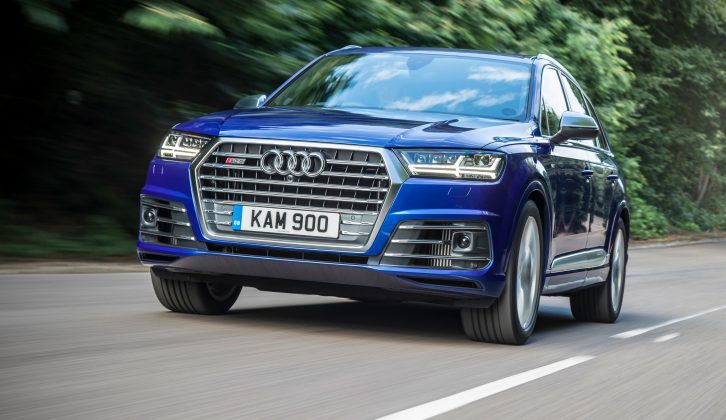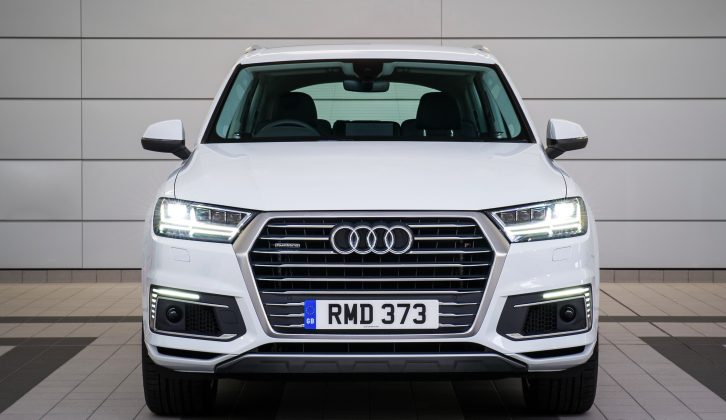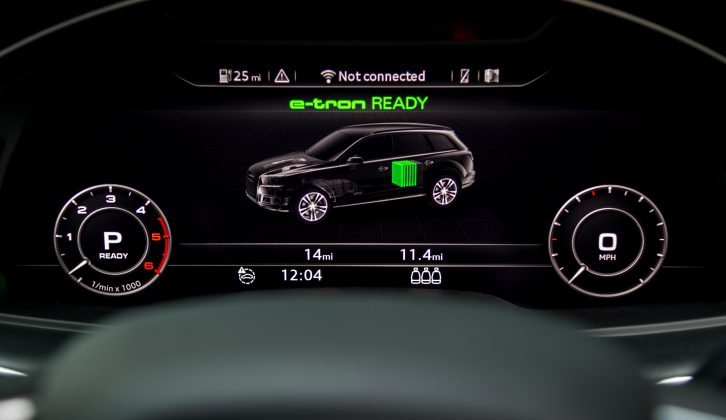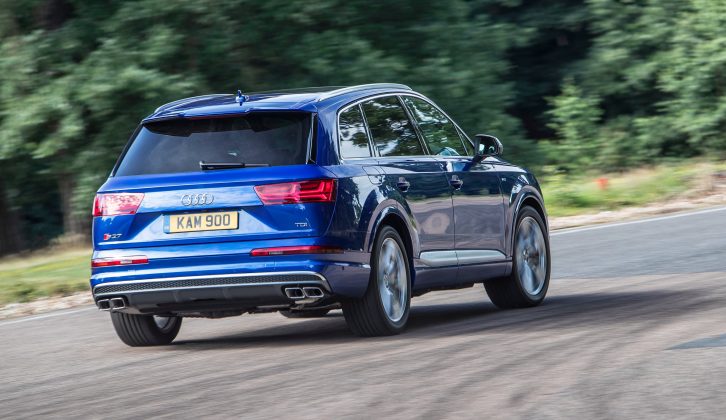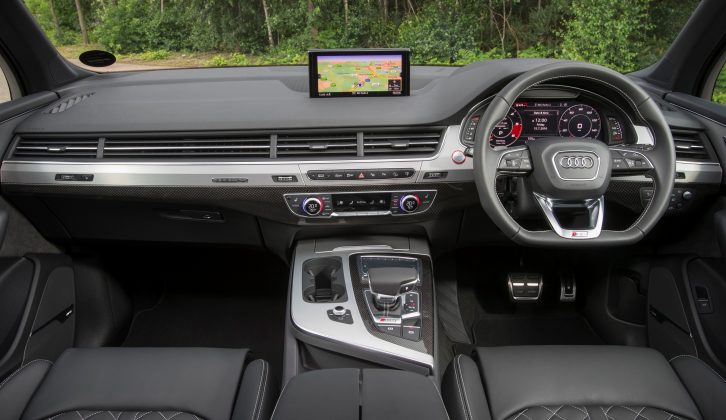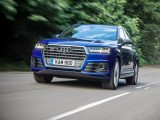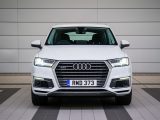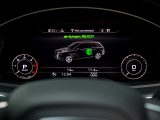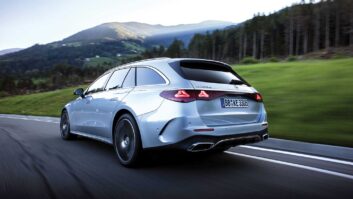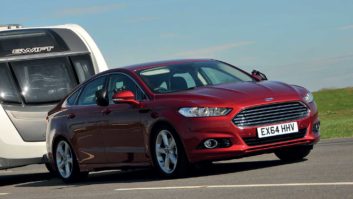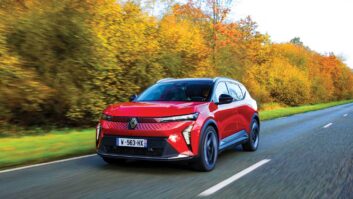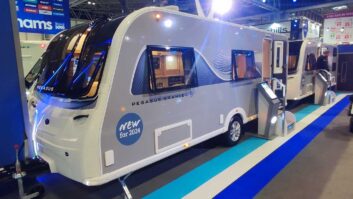One thing the Audi Q7 doesn’t need is more power. The 272PS (268bhp) Q7 was the third fastest accelerating car at the Tow Car Awards 2016, taking just 8.8 seconds to pull a big twin-axle caravan from 30-60mph.
But just because nobody needs a faster 4×4 tow car than the Q7 3.0 TDI, it doesn’t mean that nobody wants one. Step forward the SQ7 and Q7 e-tron.
The SQ7 is the more powerful of the two, with a high-tech 4.0-litre V8 TDI producing 435PS (429bhp) and a colossal 664lb ft of torque. That’s more than double the pulling power of a Hyundai Santa Fe, and enough beef for Audi to claim the SQ7 is the fastest accelerating diesel 4×4 on the market.
The claimed 0-62mph figure is 4.9 seconds, quite astonishing for a car with a kerbweight (including 75kg for the driver) of 2405kg. That’s considerably heavier than the Q7 3.0 TDI’s 2135kg kerbweight, and gives an 85% match figure of 2044kg.
I could pretend that heft is a sensible justification for choosing the SQ7 over the 3.0 TDI, but that’s stretching credibility a bit. People will buy the SQ7 for the sheer thrill of owning a seven-seat SUV that accelerates like a children’s toy hurled towards the skirting board, not because of more favourable matching ratios.
The V8 isn’t just powerful, it sounds fabulous, too, with a deep base-heavy burble that makes the 3.0 V6 diesel seem wheezy and anaemic. There’s some clever technology at work, with an electrically powered compressor working in support of the twin turbochargers at low revs, so there’s a prompt response as soon as you squeeze the throttle (peak torque arrives from just 1000rpm and is maintained all the way to 3250rpm).
The standard Audi Q7 rides and handles well, particularly when fitted with the optional air suspension. The SQ7 is in a different league in terms of cornering poise and grip, certainly when equipped with the optional Driving Dynamic Sports Pack. This costs £5700, and for the cost of a decent secondhand car you get chassis technology to match all the clever trickery under the bonnet. There’s a sports differential, four-wheel steering and electromechanical active roll stabilisation.
The roll stabilisation is especially impressive. On a series of sweeping bends, the SQ7 cornered with almost no body lean at all, turning in quickly for such a big car and feeling stable and balanced. I’d be intrigued to try the SQ7 on standard suspension, but if you’re going to buy a car this fast you might as well make sure it can corner properly as well.
Even without that option fitted, the SQ7 costs £70,970. That’s a significant step up from the £54,540 which Audi charges for a 3.0 TDI 272PS Quattro S line. It will also cost a lot more to run. Carbon dioxide emissions of 190g/km make for a standard-rate VED bill of £270, although that’s not going to frighten anyone happy to spend almost £6k on fancy suspension. The car achieves 39.2mpg on the official combined cycle, although the trip computer showed mpg in the high 20s during my test drive.
If that’s a concern, the Q7 e-tron is more likely to appeal. This plug-in hybrid is still very quick, with the 3.0-litre V6 diesel and the 94kW electric motor combining to provide 373PS (368bhp) and 516lb ft of torque. Audi claims a 0-62mph time of 6.2 seconds.
In isolation, that’s very swift. After driving the SQ7, it felt quite tame. However, there are good reasons to choose the e-tron over the faster car.
The official economy figure is 156.9mpg. Whether drivers get anywhere near that depends on how often the car can run in pure-electric mode. Running just on battery power the e-tron has a claimed range of 34 miles, although that’s in ideal conditions. Even so, someone with a short commute and a charging point installed at home could conceivably drive the car day-to-day without needing to fill up with diesel until taking a long trip.
There’s usually a compromise somewhere in making a hybrid version of a car designed for internal combustion engines, and with the e-tron that’s the omission of the third row of seating to make room for the electrics.
Another is the extra weight of the hybrid model. The kerbweight of 2520kg may give impressive matching ratios, but the e-tron doesn’t feel as wieldy as the standard car. It’s certainly not as able on twisting roads as the SQ7, taking longer to settle on its suspension when changing direction.
With a price tag of £64,950, it’s less expensive than the SQ7 but still significantly more than the conventional 3.0-litre diesel models. It makes most sense for company car drivers with short commutes, who will pay tax based on the official carbon dioxide emissions of 48g/km (or 50g/km for cars with 20-inch alloy wheels).
For a private buyer with long drives on caravan holidays in mind, though, the case for the e-tron is less obvious. But it’s certainly easier to make than arguing in favour of the SQ7, however quick, entertaining and downright bonkers it may be.
People will buy the SQ7 for the sheer thrill of owning a seven-seat SUV that accelerates like a children's toy hurled towards the skirting board
